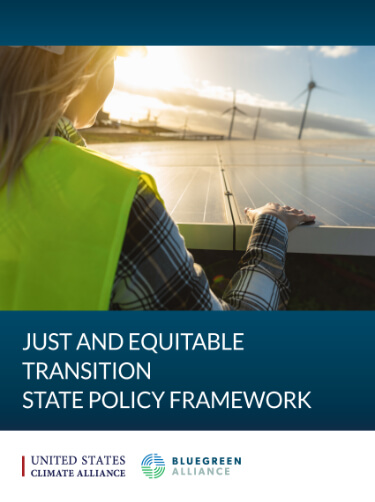Home / U.S. Climate Alliance Releases New Tools to Help States Confront Climate Crisis, Drive Just and Equitable Transition

WASHINGTON, D.C. – As the Biden Administration and the nation’s governors prepare to supercharge climate action with the recently signed Inflation Reduction Act, the U.S. Climate Alliance today released new tools and resources to help states better utilize the social cost of greenhouse gases and deliver a more just and equitable transition.
“As our states push to deliver the next generation of climate actions, we will ensure they have every tool at their disposal and facilitate opportunities to continue learning from one another,” said Alliance Managing Director Taryn Finnessey.
The Social Cost of Greenhouse Gases: A Guide for State Officials helps inform and support states’ use of the social cost of greenhouse gases (SC-GHG) in policymaking and analysis. The SC-GHG provides a set of estimates of how much damage results, in monetary terms, from the emission of one additional metric ton of carbon dioxide, methane, nitrous oxide, and other GHGs. By assigning a monetary value to the harm caused by GHG emissions, the SC-GHG enables two sorts of comparisons: first, between the climate and non-climate effects of a given policy, activity, or decision; and second, between the climate effects of a policy, activity, or decision and the climate effects of an alternative.
The Guide, produced for the Alliance by the Institute for Policy Integrity at New York University School of Law covers the SC-GHG’s intellectual and institutional origins; its key concepts and features; legal context, authority and considerations; and its application. Notably, more than a dozen states have used the SC-GHG in to inform policymaking and decisions.
The Just and Equitable Transition State Policy Framework and its accompanying Resource Guide serve as a toolkit for states that want to build and strengthen just and equitable transition policies. These resources, produced in collaboration with the BlueGreen Alliance, detail dozens of examples, ideas, strategies, and best practices. In addition to helping states transition to a clean energy future and regenerative economy, these resources are also intended to help: enable and elevate worker and community voices through stakeholder engagement and collaborative planning processes; ensure an equitable, inclusive, and sustainable workforce; and achieve community health, longevity, and resilience. Given the collaborative nature of the Alliance’s work, the Framework also provides a number of examples that may serve as precedent for multi-state transition policy strategies.
These new tools are part of a series of resources released by the Alliance to support state-led climate action across sectors and policy areas, including: the Governors’ Climate Resilience Playbook, Building Decarbonization Roadmap, and Natural and Working Lands Inventory Improvements: A Guide for States.
The Social Cost of Greenhouse Gases: A Guide for State Officials can be read in full here and The Just and Equitable Transition State Policy Framework and its accompanying Resource Guide can be read in full here.
Launched in 2017 by the governors of Washington, New York, and California to help fill the void left by the U.S. federal government’s withdrawal from the Paris Agreement, the Alliance has grown to include 24 governors from across the U.S. representing approximately 60 percent of the U.S. economy and 55 percent of the U.S. population. Governors in the Alliance have pledged to collectively reduce net greenhouse gas emissions by at least 26-28 percent by 2025, 50-52 percent by 2030, and 61-66 percent by 2035, all below 2005 levels, and collectively achieve overall net-zero greenhouse gas emissions as soon as practicable, and no later than 2050.
The Alliance’s states and territories continue to advance innovative and impactful climate solutions to grow the economy, create jobs, and protect public health, and have a long record of action and results. In fact, the latest data shows that as of 2023, the Alliance has reduced its collective net greenhouse gas emissions by 24 percent below 2005 levels, while increasing collective GDP by 34 percent, and is on track to meet its near-term climate goal of reducing collective greenhouse gas emissions 26 percent below 2005 levels by 2025.
###